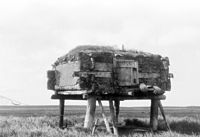
Photo from wikipedia
The ever-increasing demand for fish as a food, has led to the development of new handling and packaging technologies resulting in premium quality fish products. In order to avoid frauds… Click to show full abstract
The ever-increasing demand for fish as a food, has led to the development of new handling and packaging technologies resulting in premium quality fish products. In order to avoid frauds reaching the market, fish quality assurance methods need to be developed. In this study, two statistical models of biochemical processes that occur in Atlantic salmon during two weeks of storage at 0 and 4 °C were developed. These models were further used to detect salmon quality and its storage conditions. The biochemical processes were monitored using Nuclear Magnetic Resonance (NMR) spectroscopy and principal component analysis (PCA). The Soft Independent Modeling of Class Analogy (SIMCA) approach was applied to develop and evaluate the models. The fraud detection potential of the models was tested using samples of various quality and storage parameters. It was shown that the developed models are able to discriminate quality, time and temperature of stored Atlantic salmon.
Journal Title: Food chemistry
Year Published: 2018
Link to full text (if available)
Share on Social Media: Sign Up to like & get
recommendations!